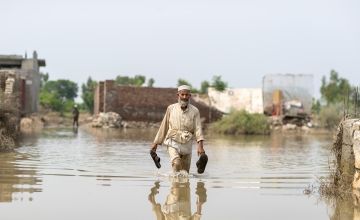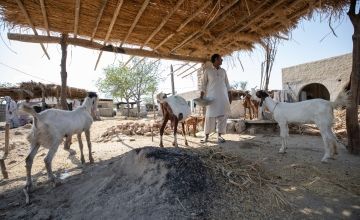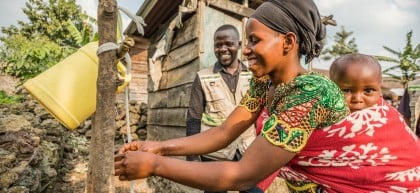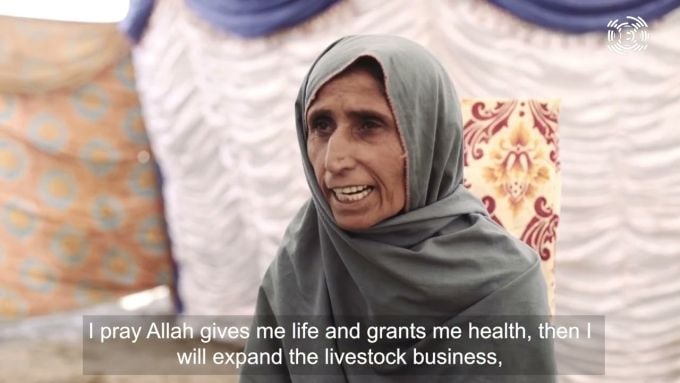
Knowledge Hub
Last year’s catastrophic floods in Pakistan not only destroyed homes and buildings, but also robbed millions of their ability to earn a living.
In August and September 2022, heavy monsoon rains in Pakistan triggered devastating floods across the country, with United Nations secretary general António Guterres calling the flooding a “monsoon on steroids”. At one point, one third of the country was underwater.
Over 1,700 people were killed, 800,000 cattle and other livestock died, and 2.2 million houses were damaged or destroyed. In all, 33 million people were affected - losing their homes, lands or jobs - and $30 billion in damages were inflicted on Pakistan. In addition, the floods damaged most water systems in affected areas, forcing more than 5.4 million people, including 2.5 million children, to rely on contaminated water from ponds and wells for drinking, washing and cooking, resulting in outbreaks of waterborne diseases like cholera and diarrhoea.
Stories from Sindh - how the floods changed Maula's life
Sindh was one of the areas of Pakistan worst affected by the floods. According to the Government of Sindh Provincial Disaster Management Authority (PDMA), over 12.3 million people in Sindh were affected, with 1,003 people killed. In addition to the damage and destruction of homes, schools and health centres, over 430,000 livestock died in the floods, and over 3.7 million acres of crops were damaged.
Maula, a farmer from Sindh, said: “During the floods, I felt like we were witnessing Judgement Day. So much water entered our homes. We could not even sit on our charpoys [a traditional woven bed] as the water rose above them. Everything was destroyed in the water. The cotton crops we had sown, the animals… we lost it all. I saw people falling so ill. Our houses collapsed under the force of the rain and we had to seek shelter in tents on the nearby main roads.”
Khairi, who lives with her son, daughter-in-law and three grandchildren in Sindh, added: “During the monsoon last year, the water entered our home. There was water on all four sides outside three weeks. Because the rain was constantly leaking through the roof, we could not even light the stove and cook food. We would wade through the water and go to our neighbours’ homes to cook or even make chai.”
During the floods, I felt like we were witnessing Judgement Day


A climate-related disaster
While monsoon rains vary in their severity in Pakistan, it is believed that climate change contributed to the intensity of last year’s rains.
A report from a team of international scientists found that climate change, caused by human-induced greenhouse gas emissions, could have increased the most intense rainfall over a short period in Sindh and Balochistan provinces, the worst affected areas, by about 50%. It also found that similar events are likely to become more frequent as global temperatures continue to rise.
Pakistan is the world’s sixth most populous country, but in 2020, it was responsible for less than 1% of global emissions. That’s less than one eighth of the US’s per capita emissions. Despite this, Pakistan is one of the countries most vulnerable to climate change, which is even more serious when over 40% of the working population is employed in agriculture.
Many of those who sought shelter in tents, mosques and community centres returned weeks or months later to find that their houses had been destroyed. The roof of Maula’s house, which he had built just a year earlier, had caved in, and he was forced to patch up the damage with mud, straw and plastic sheeting to protect his family.
Making the situation even more difficult was the loss of livestock, destruction of crops and damage of land. Many people in Sindh depend on agriculture for income and feeding their families - from Maulo, a farmer who used to own 25 animals and grew cotton, mustard and wheat on his land, to Zainab, a widowed mother-of-one who took care of a landowner’s goats and split the profits from the sale of the kids and the goat’s milk. But the decimation of land and livestock in the floods left millions unable to grow crops or rear animals. A lack of usable farmland meant that labourers were scrambling for daily work to put food on the table, and prices for food were spiralling.
Maulo, a father of six children, explained: “It was very difficult to survive. It became impossible to earn a living after the rains. There was no cultivable land and we could not grow any crops for the season. Labourers had nowhere to work. We were at the mercy of the Lord, and survived by doing odd jobs. I had to sell the animals that had survived the rains. We did not have the funds to plough the land or purchase the seed. The situation was so dire that I gave up. I felt like I would never be able to use the land again.”

Restoring livelihoods
Concern Worldwide has worked in Pakistan for 22 years, including the Sindh province. Following the floods, our teams’ assessment found that communities affected by the floods needed support to restore their livelihoods in a way that can withstand climate-induced disasters.
In April this year, we held a livestock market and invited 100 households from five villages in Sindh, focusing on the most vulnerable households, including female-run homes, large families with young dependents, and people with disabilities. Four vendors from local markets brought goats for sale, with Concern covering part of the cost. Many of those buying the goats at the market explained they would use the goat to provide for their families, by selling milk or the goat’s kids - including Zainab, who hopes to use the goat’s milk to pay for family expenses, and her daughter’s medical bills, and wants to grow a livestock business following this first step.
Khairi also came to the market to buy a goat. Due to her age, she is no longer able to work in the fields, and supplemented her family’s income by sharing two goats with somebody else and splitting the costs and profits. Now, she is excited to have livestock of her own.
She said: “I plan to give my grandchildren the goat’s milk and when it has children, I will sell them. My daughter-in-law is pregnant now with her fourth child, and her youngest, who is almost two years old, cannot feed from her now, so I hope that he will like the goat’s milk. I want to buy my grandchildren new clothes, to stock the home with food and some small things that we need.
“Today is a very happy day for me. All my life I have worked for others – on their land or taking care of their livestock. This is the first thing in my life that will be just mine – not shared or split with anyone.
That makes me smile every time I think about it.

Building resilience
It is essential in countries like Pakistan to adapt and use climate-smart techniques in agriculture to mitigate the effects of climate change. Concern introduced Farmer Field Schools to train local farmers in climate smart agriculture and conservation agriculture techniques - including how to select the best quality and most seasonal seeds, how to prepare land and apply nutrients to soil, and how to prevent soil erosion. We also provided fertiliser and seeds, allowing farmers like Maula to rebuild their harvests.
He said: “They taught us so much. They supported us when we could not stand on our own. Before, if we spent money on fertiliser, we would not have money left over for seeds, and if we spent funds ploughing the land or using a tractor, we would not have money for fertiliser, and so on. We had no hope. But Concern removed those problems by giving us material assistance. Now we are cultivating cotton crops and after it is harvested, we will cultivate wheat crops.”

Speaking about the new techniques he learned through training, Maula added: “We have learned how to better plough the land, how water is released in the soil after ploughing. We had no idea about these techniques before. We have seen great results from using these techniques. Previously, the seed would be buried deep in the earth and would not rise and grow, or it remained on the surface and would dry and get wasted. But with these new methods, the land is utilised properly, each seed is planted in a way that it is protected. We will reap what we sow, and we have sowed our crops with the best possible knowledge and techniques.”
Students at the Farmer Field Schools have been encouraged to share what they have learned throughout their villages, so the education can spread. While Pakistan is still recovering from the devastation of last year, these steps will help communities to rebuild their lives, and protect themselves and their livelihoods.




